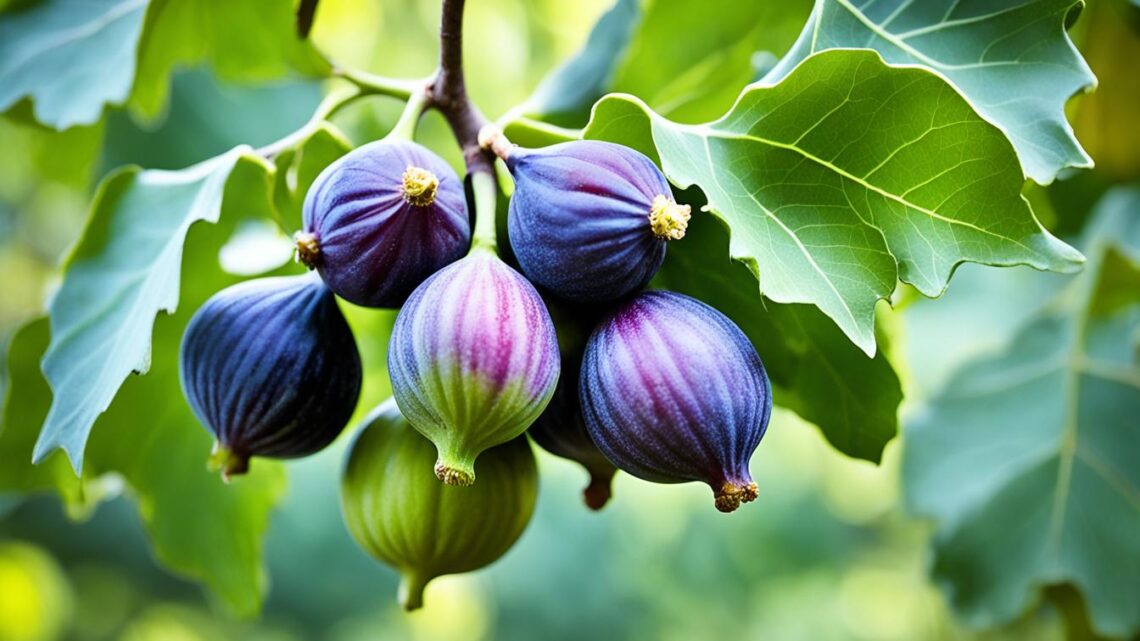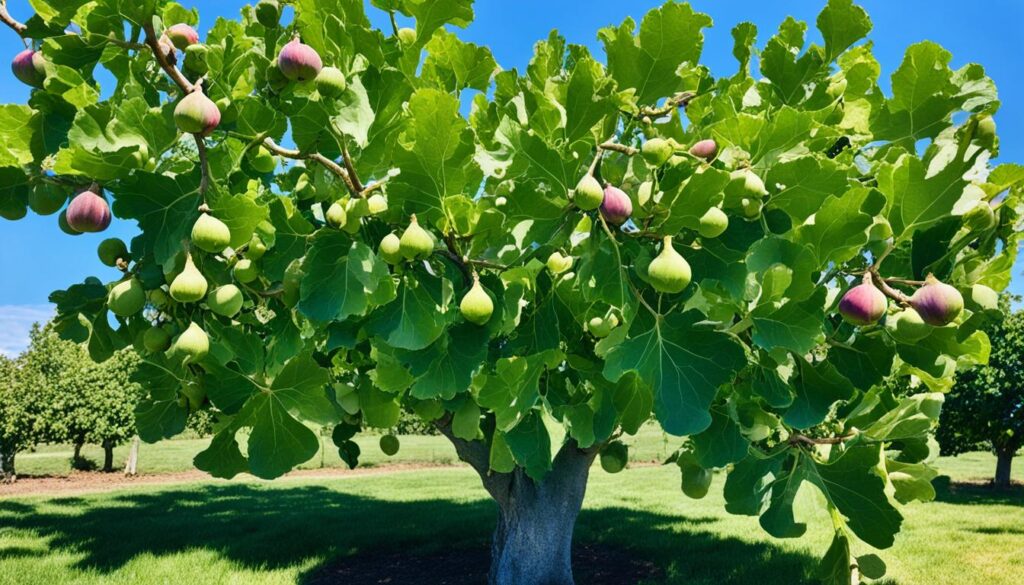
Have you thought about adding a fig tree to your garden? These trees are easy to grow and give you lots of sweet, juicy fruits. They also add a Mediterranean look to your garden. Let’s dive into the world of Ficus carica and learn more about these ancient, edible trees.
Why are Ficus carica trees so popular in gardens and orchards in the U.S.? They grow big, fight off pests, and are full of nutrients. Let’s explore the history, how to grow them, and the tasty foods you can make with them.
Introduction to Ficus carica: The Common Fig Tree
The Ficus carica, also known as the common fig, is a tree or shrub in the mulberry family (Moraceae). It comes from the Mediterranean and Central Asia. This plant grows up to 10 to 30 feet tall and wide.
The name Ficus means «edible fig.» Carica comes from the Caria region in southwestern Turkey, famous for figs.
What is Ficus carica?
The Ficus carica tree grows in a region from Asiatic Turkey to northern India. It can be a bush or a small tree, 1 to 10 to 12 meters tall. Ficus carica is easy to grow from cuttings taken in February.
Benefits and Nutritional Value of Figs
Figs, or syconia, grow alone or in pairs above the leaves or in the leaves’ axils. The Ficus carica fruit is full of calcium, potassium, phosphorus, and iron. Dried figs are great antioxidants, both in tests and in real life.
- Figs are full of vitamins and minerals like calcium, potassium, phosphorus, and iron.
- Dried figs are top antioxidants, showing their benefits in labs and in real life.
- Figs have many phenolic compounds, which help with their nutrition and health perks.
- The fig fruit is low in calories but high in water, making it good for a healthy diet.
Ficus carica trees are valued for their nutrition and versatility. They have been grown and enjoyed worldwide. The common fig is a standout in gardens and landscapes.

Varieties of Fig Trees
There are over 800 types of figs, all part of the Ficus carica species. These fig trees come in many sizes and colors. They also vary in fruit season and climate needs.
LSU Purple Fig
The LSU Purple Fig grows well in USDA Zones 7 to 10. It can get 10 to 15 feet tall. This fig tree produces large, deep purple fruits with sweet flesh.
It has two crops: one in spring and another in summer or early fall.
Black Mission Fig
The Black Mission Fig is a favorite for centuries. It grows in USDA Zones 8 to 10 and can reach 30 feet. Its fruits are large, dark purple-black, and very sweet.
They are great for eating fresh, making preserves, and baking.
Celeste Fig
The Celeste Fig, or «Sugar Fig,» is a cold-hardy variety for USDA Zones 7 to 10. It grows 10 to 15 feet tall and has small to medium fruits. These fruits have a light brown skin and taste like honey.
They are perfect for eating fresh, canning, and drying.
Brown Turkey Fig
The Brown Turkey Fig grows in USDA Zones 7 to 10. It can get up to 20 feet tall. Its fruits are large and have a bronze-brown skin.
The flesh is soft and amber-colored. This fig is known for producing two crops, making it great for gardens and orchards.
Chicago Hardy Fig
The Chicago Hardy Fig can handle cold temperatures down to USDA Zone 6. It grows 10 to 15 feet tall. Its fruits are medium-sized and have a green-to-purple skin.
The pulp tastes like strawberries. This fig is ideal for gardeners in cooler areas who love fresh figs.
Ficus carica: Planting and Care Guide
Growing Ficus carica, or the common fig tree, requires careful planting and upkeep for a good harvest. This guide covers selecting the best spot and soil, and how to water and fertilize your fig trees. Follow these tips to grow healthy fig trees in your garden.
Choosing the Right Location and Soil
Figs do well in soil that drains well and is rich in organic matter. The ideal pH is between 6.0 and 6.5. Pick a spot that gets full sun to partial shade. They need 6-8 hours of sunlight daily for growth and fruiting. Stay away from heavy clay soils or areas that stay wet, as figs don’t like wet feet.
Planting and Transplanting Tips
When planting fig trees, dig a hole twice as wide and as deep as the root ball. Place the tree in the hole, making sure the root ball is level with the soil. Fill the hole with the original soil and water well to settle the roots. For transplanting fig trees, do it in early spring or late fall when the tree is dormant. Follow the same steps as for planting.
Watering and Fertilizing Needs
Watering fig trees is key, especially when they’re growing. Keep the soil moist but don’t overdo it to prevent root rot. Water the tree once or twice a week, depending on the weather and soil moisture.
To fertilize fig trees, use a balanced, slow-release fruit tree fertilizer. Put it on in early spring, as directed, and don’t overdo it. Too much fertilizer can make the tree focus on leaves instead of fruit.
Pruning and Harvesting Figs
Keeping your fig tree (Ficus carica) healthy and productive needs careful pruning and harvesting. Proper pruning boosts fruit production. Harvesting at the right time lets you enjoy the sweet, ripe figs.
Prune fig trees in early spring or late fall when they’re dormant. This helps them grow well and reduces stress. When the tree is young, pruning can cut its size in half. This shapes the tree to be smaller and easier to manage.
- Pruning helps the tree grow strong and healthy.
- Removing dead or damaged branches keeps the tree in good shape.
- Good pruning leads to more figs and tastier harvests.
Harvesting figs at the right time is key. Pick them when they’re soft and bend at the neck. Don’t take figs that are still hard, as they might not taste sweet.
| Fig Ripening Characteristics | Harvest Recommendations |
|---|---|
| Slightly soft texture and bending at the neck | Figs are ready to be harvested |
| Firm figs | Not yet fully ripe, leave on the tree to continue ripening |
Learning how to prune and harvest fig trees ensures a great fig crop every year. Prune during the dormant season and harvest when figs are ripe for the best outcome.
Growing Ficus carica in Containers and Overwintering
If you live in a cold area or have limited garden space, consider growing Ficus carica, the common fig tree, in containers. These trees do well in the right pot and with proper care. You can enjoy their fruits even where fig trees might not survive the winter.
Choose a container that’s at least 15-20 gallons for your fig tree. Use a potting mix made for containers and make sure it has good drainage holes. Add coarse bark chips and coarse sand to the soil to help it drain better.
Water and feed your fig tree in containers right. Keep the soil moist but not too wet. Use a slow-release fertilizer with balanced nutrients for healthy growth and lots of fruit.
If winter gets too cold, you need to protect your fig tree. Move it indoors when the first frost hits. Keep it in a spot with temperatures between 20 and 50 degrees Fahrenheit. Just water it a little during this time to keep the roots from drying out.
When spring comes, slowly get your fig tree used to being outside again. Cut off any dead branches and watch it come back to life. Soon, you’ll have fresh figs to enjoy.
Learning how to grow Ficus carica in containers and protect it in winter lets you enjoy its tasty fruits in cold places. With the right care, your fig tree can be a great addition to your garden or patio.
| Variety | Cold Hardiness | Fruit Characteristics |
|---|---|---|
| Chicago Hardy Fig | USDA Zones 6-10 | Small to medium-sized, purplish-brown fruit with sweet, rich flavor |
| Celeste Fig | USDA Zones 7-10 | Small to medium-sized, light brown fruit with a delicate, honey-like taste |
| Brown Turkey Fig | USDA Zones 7-10 | Medium to large, brown-purple fruit with a sweet, syrupy flavor |
When picking a fig tree for containers and wintering, choose ones that can handle the cold, like Chicago Hardy, Celeste, or Brown Turkey. These varieties are good for cooler places and do well in containers. They give you a steady fig harvest every year.
Pests, Diseases, and Other Challenges
The Ficus carica, or common fig tree, is usually tough and resilient. But, it can sometimes face pest and disease issues. It’s important to know about these problems and act early to keep your fig tree healthy and productive.
Common Pests and Diseases
Aphids, scale insects, spider mites, and mealybugs are pests that can harm fig trees. They eat the leaves, stems, and fruit, slowing down the tree’s growth. Fig trees can also get diseases like blight, leaf spots, and rust. These diseases can hurt the tree’s health and look.
Preventing and Addressing Issues
To stop and fix fig tree pests and diseases, watch your tree closely for any signs of trouble. Here are some steps you can follow:
- Keep the area around the tree clean by removing fallen fruit, leaves, and debris. These can hide pests and diseases.
- Help control pests by encouraging natural predators like ladybugs and lacewings.
- If you need to, use organic pest control products. But, always read and follow the instructions carefully.
- Prune the tree to make sure air can move freely. This can lower the chance of fungal diseases.
- Make sure your fig tree gets enough water, sunlight, and nutrients. This keeps it healthy and strong.
By being alert and acting early on fig tree problems, you can help your Ficus carica stay healthy for many years.
Harvesting, Storing, and Using Figs
Enjoying the fruits of your fig tree requires knowing how to harvest and store them. Figs are ready when they feel soft and come off the tree easily, usually in late summer or early fall. It’s key to handle them gently to prevent damage.
Harvesting Techniques
To pick figs, twist and lift them from the tree with your palm. Don’t pull or jerk them, as this can cause damage. Put the figs in a shallow container to keep them from getting crushed. Harvest them in the cooler parts of the day for the best freshness.
Storing and Preserving Figs
Fresh figs don’t last long, staying fresh for just a few days at room temperature. To keep them longer, put them in the fridge for up to a week. For longer storage, freeze, dry, or can them. Frozen figs last months, and dried or canned ones can be enjoyed all year.
Culinary Uses for Figs
Figs are versatile and can be used in many dishes. Enjoy them fresh, in salads, tarts, or desserts. They also go well with cheese, grilled meats, and roasted veggies. Plus, use them in jams, preserves, and baked goods for a sweet and unique flavor.



